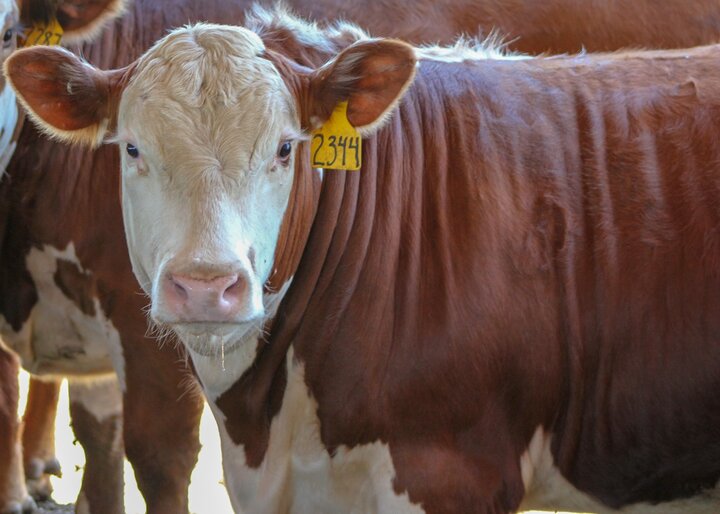Metaphylaxis (administration of FDA antimicrobial, generally via injection, to high-health risk cattle upon arrival) is used to help manage bovine respiratory disease (BRD). The use of metaphylaxis is known to decrease the mortality and morbidity of cattle in feedlots. Producers managing high-health risk cattle with metaphylaxis must choose the type of cattle to purchase in conjunction with the price paid and the antimicrobial to use. Thus, the effectiveness of the metaphylaxis protocol can vary based on cattle placement weight, placement season, gender, and antimicrobial use (Nickell and White, 2010; DeDonder and Apley, 2015; Ives and Richeson, 2015).
In a recent study, we compared the costs and benefits associated with the use of metaphylaxis (or no metaphylaxis) to determine how metaphylaxis affects net return distributions for fed cattle. Net returns were measured across cattle placement weight (600 or 800 pounds), placement season (October to March referred to as “Winter” or April to September referred to as “Summer”), and the antimicrobial tier administered. (“Upper Tier” antimicrobial, “Lower Tier” antimicrobial, or no metaphylaxis). These findings have important implications for producers deciding how, when, and what type of antimicrobial to use for metaphylaxis.
Procedures
The net return model incorporated how antimicrobials modify BRD health and performance outcomes. Health and performance outcomes were calibrated from published literature and proprietary feedlot data. Three parameters were used to evaluate the effect of metaphylaxis on morbidity: average feed conversion, health costs, and average daily gain. Mortality was predicted based upon cattle placement weight, season, and the antimicrobial used for metaphylaxis. A simulation model was used to evaluate net returns in which sick cattle increase health and feed costs while decreasing average daily gain, losing the initial cost of cattle if they die, and incurring additional yardage, feed, interest, and health costs, all of which affect total costs to the operation.
Proprietary data came from 10 Midwestern feedlots representing nearly six million animals and 50,000 cohorts between 1989 and 2015. Twelve placement-by-metaphylaxis decision combinations were assessed: high health risk steer placement attributes were 600 or 800 lb. steers placed in Winter (Oct-Mar) or Summer (Apr-Sept) managed with one of three different health programs: “no metaphylaxis”, “Upper Tier” antimicrobial, or “Lower Tier” antimicrobial. Net return distributions were compared between “no metaphylaxis” and a specific antimicrobial tier within specific cattle populations.
Key Findings
A complete listing of net return combinations is found in Table 1. Results indicated higher mortality caused increased feed conversion, increased health costs, and lower daily gains. Both the “Upper Tier” and “Lower Tier” antimicrobials reduced expected mortality when used for metaphylaxis on high-risk cattle. High-risk cattle not treated using metaphylaxis had the largest mortality as well as higher mortality variation across all seasons and weight placements. When compared to “Lower Tier” antimicrobials used for metaphylaxis, “Upper Tier” antimicrobials had lower mortality while no metaphylaxis use had higher mortality. For summer placements, the difference in expected net returns per head between administering an “Upper Tier” (“Lower Tier”) to “no metaphylaxis” was $96.08 ($50.39) for 600 pounds and $90.36 ($51.14) for 800 pounds. The difference in expected net returns per head for winter placement between administering an “Upper Tier” (“Lower Tier”) to “no metaphylaxis” was $122.55 ($65.72) for 600 pounds and $148.65 ($49.65) for 800 pounds.
| Net Returns ($/head) | 600 lb. Placement Weight | 800 lb. Placement Weight | ||||||
|---|---|---|---|---|---|---|---|---|
| Summer (Apr-Sept) | Winter (Oct-Mar) | Spring (Apr-Sept) | Winter (Oct-Mar) | |||||
| Upper | Lower | Upper | Lower | Upper | Lower | Upper | Lower | |
| Metaphylaxis | ||||||||
| (-∞,-251) | 0.00 | 1.64 | 0.00 | 4.40 | 0.00 | 0.04 | 0.00 | 0.04 |
| (-251, -51) | 1.64 | 37.56 | 3.64 | 40.32 | 0.08 | 41.72 | 0.00 | 76.64 |
| (-50, 0) | 34.12 | 40.56 | 34.44 | 33.12 | 41.68 | 51.68 | 47.80 | 23.00 |
| (0, 50) | 64.24 | 20.24 | 61.92 | 22.16 | 58.24 | 6.56 | 52.20 | 0.32 |
| (>51) | 0.00 | 0.00 | 0.00 | 0.00 | 0.00 | 0.00 | 0.00 | 0.00 |
| No Metaphylaxis | ||||||||
| ( | 7.08 | 7.08 | 12.56 | 12.56 | 2.16 | 2.16 | 4.68 | 4.68 |
| (-251, -51) | 35.64 | 35.64 | 34.56 | 34.56 | 44.04 | 44.04 | 79.68 | 79.68 |
| (-50, 0) | 24.24 | 24.24 | 21.00 | 21.00 | 34.12 | 34.12 | 14.56 | 14.56 |
| (0, 50) | 33.04 | 33.04 | 28.16 | 28.16 | 19.68 | 19.68 | 1.08 | 1.08 |
| (51,+∞) | 0.00 | 0.00 | 3.72 | 3.72 | 0.00 | 0.00 | 0.00 | 0.00 |
Notes: aAntimicrobials used for metaphylaxis are categorized into “upper” and “lower” tiers based on Abell et al. (2017) who categorized them based on odds ratio (OR) confidence intervals.
Source: Author’s calculations.
Discussion
The probability of large losses was greatly reduced through the administration of metaphylaxis in high health risk cattle. Based on these estimated return distributions, feedlots can expect lower variability in morbidity and mortality and higher profits using metaphylaxis. The results of this study are intended to aid in maximizing producer profits using metaphylaxis as a strategy to reduce the impacts of BRD in high health risk cattle. The full article can be found here.
Interviews with the authors of BeefWatch newsletter articles become available throughout the month of publication and are accessible at https://go.unl.edu/podcast.

